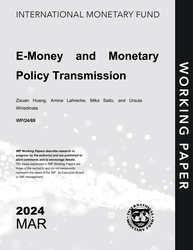
E-Money and Monetary Policy Transmission
E-Money and Monetary Policy Transmission
READ MORE...
Volume/Issue:
Volume 2024
Issue 069
Publication date: March 2024
ISBN: 9798400270543
$20.00
Add to Cart by clicking price of the language and format you'd like to purchase
Available Languages and Formats
| English |
Prices in red indicate formats that are not yet available but are forthcoming.
Topics covered in this book
This title contains information about the following subjects.
Click on a subject if you would like to see other titles with the same subjects.
Banks and Banking , Finance , Economics- Macroeconomics , Money and Monetary Policy , Economics / General , Monetary policy transmission , banks , nonbank financial institutions , e-money , panel data , e-money development , e-money issuer , e-money intensity , E-Money intensity , Financial inclusion , Central bank policy rate , Deposit rates , Bank credit , Sub-Saharan Africa , Africa
Summary
E-money development has important yet theoretically ambiguous consequences for monetary policy transmission, because nonbank deposit-taking e-money issuers (EMIs) (e.g., mobile network operators) can either complement or substitute banks. Case studies of e-money regulations point to complementarity of EMIs with banks, implying that the development of e-money could deepen financial intermediation and strengthen monetary policy transmission. The issue is further explored with panel data, on both monthly (covering 21 countries) and annual (covering 47 countries) frequencies, over 2001 to 2019. We use a two-way fixed effect estimator to estimate the causal effects of e-money development on monetary policy transmission. We find that e-money development has accompanied stronger monetary policy transmission (measured by the responsiveness of interest rates to the policy rate), growth in bank deposits and credit, and efficiency gains in financial intermediation (measured by the lending-to-deposit rate spread). Evidence is more pronounced in countries where e-money development takes off in a context of limited financial inclusion. This paper highlights the potential benefits of e-money development in strengthening monetary policy transmission, especially in countries with limited financial inclusion.
Copyright © 2010 - 2025
Powered by:
AIDC



